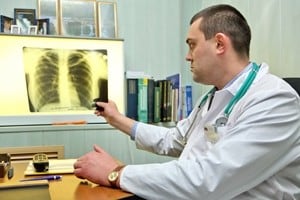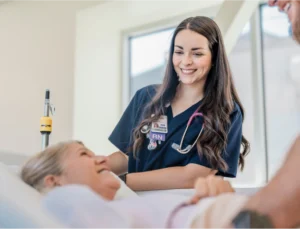 As a certified medical assistant, paying attention to new developments in the treatment of infectious diseases, like pneumonia, is important. According to a study published in The Journal of the American Osteopathic Association, lymphatic pump treatment1 may be an infection’s worst enemy. Used hand-in-hand with antibiotics, LPT helps manage pneumonia and in some cases, completely erases it from the body. While LPT has been used in the past to treat infectious diseases, this is the first case where the drug was found to also improve a drug’s efficiency. What is LPT? An osteopathic manipulative technique, LPT increases the flow of lymph, a fluid comprised of white blood cells, which breaks up harmful bacteria collected in the lungs. When lymph is restricted, a patient’s immune system is at risk for disease or infection. By aiding the flow of the lymphatic system, LPT helps vaccine-specific antibodies spread, decreasing the need for intravenous drugs to fight blockages. While medical assisting, you may see patients with pneumonia experience reduced hospital stays. With increased lymphatic flow and drainage, the immune system is able to successfully notice and attempt to eliminate anything foreign that will cause a reaction. Decline of antibiotic-resistant research According to the Infectious Diseases Society of America, there has been a decrease in developing new antibiotics2. As antibiotic-resistant diseases, like MRSA, continue to spread, the research into new drugs and cures needs to increase. Since these diseases are diverse and continue to change over time, modern medicine must rise to meet the demand. The main reason for the slow, if not almost halted, development of new antibiotics is the return on investment. As a pharmacy technician, you will be interacting with a number of diverse drugs. In comparison to drugs that are used to treat long-term illnesses, antibiotics are only used for a short period of time. It takes more money to produce antibiotics than it does to sell them. Companies today are tending to focus more on drugs for chronic diseases, which will lead to a higher profit. Next stages for LPT Preliminary tests on diseased rats were a huge success. Three rounds of LPT, followed by a injected dose of levofloxacin, a commonly used pneumonia antibiotic, resulted in 60 percent of rats being disease free. Only 25 percent of diseased rats given just the intravenous antibiotic were found to have overcome the disease, according to Dr. Lisa Hodge, professor of molecular biology and immunology at the University of North Texas Health Science Center. LPT could become a life-saver for lymphatic infections. As strains of antibiotic-resistant bacteria continue to come into existence, the medical community has to find new ways to keep on pace. While further testing of LPT is necessary, early testing shows the treatment boosts immune system function3 and could be a viable option for lessening or eradicating lymphatic diseases. 1“Lymphatic Pump Treatment as an Adjunct to Antibiotics for Pneumonia in a Rat Model,” by Lisa M. Hodge, The Journal of the American Osteopathic Association, May 2015. http://jaoa.org/Article.aspx?articleid=2291219 2“The Epidemic of Antibiotic-Resistant Infections: A Call to Action for the Medical Community from the Infectious Diseases Society of America,” by Brad Spellberg, Clinical Infectious Diseases, December 2007. http://www.idsociety.org/uploadedFiles/IDSA/Policy_and_Advocacy/Current_Topics_and_Issues/Advancing_Product_Research_and_Development/Bad_Bugs_No_Drugs/Statements/Epidemic_of_Antibiotic-Resistant_Infections_Spellberg_2008.pdf 3“Osteopathic lymphatic pump techniques to enhance immunity and treat pneumonia,” by Lisa M. Hodge, International Journal of Osteopathic Medicine, March 2012. http://www.ncbi.nlm.nih.gov/pmc/articles/PMC3437985/
As a certified medical assistant, paying attention to new developments in the treatment of infectious diseases, like pneumonia, is important. According to a study published in The Journal of the American Osteopathic Association, lymphatic pump treatment1 may be an infection’s worst enemy. Used hand-in-hand with antibiotics, LPT helps manage pneumonia and in some cases, completely erases it from the body. While LPT has been used in the past to treat infectious diseases, this is the first case where the drug was found to also improve a drug’s efficiency. What is LPT? An osteopathic manipulative technique, LPT increases the flow of lymph, a fluid comprised of white blood cells, which breaks up harmful bacteria collected in the lungs. When lymph is restricted, a patient’s immune system is at risk for disease or infection. By aiding the flow of the lymphatic system, LPT helps vaccine-specific antibodies spread, decreasing the need for intravenous drugs to fight blockages. While medical assisting, you may see patients with pneumonia experience reduced hospital stays. With increased lymphatic flow and drainage, the immune system is able to successfully notice and attempt to eliminate anything foreign that will cause a reaction. Decline of antibiotic-resistant research According to the Infectious Diseases Society of America, there has been a decrease in developing new antibiotics2. As antibiotic-resistant diseases, like MRSA, continue to spread, the research into new drugs and cures needs to increase. Since these diseases are diverse and continue to change over time, modern medicine must rise to meet the demand. The main reason for the slow, if not almost halted, development of new antibiotics is the return on investment. As a pharmacy technician, you will be interacting with a number of diverse drugs. In comparison to drugs that are used to treat long-term illnesses, antibiotics are only used for a short period of time. It takes more money to produce antibiotics than it does to sell them. Companies today are tending to focus more on drugs for chronic diseases, which will lead to a higher profit. Next stages for LPT Preliminary tests on diseased rats were a huge success. Three rounds of LPT, followed by a injected dose of levofloxacin, a commonly used pneumonia antibiotic, resulted in 60 percent of rats being disease free. Only 25 percent of diseased rats given just the intravenous antibiotic were found to have overcome the disease, according to Dr. Lisa Hodge, professor of molecular biology and immunology at the University of North Texas Health Science Center. LPT could become a life-saver for lymphatic infections. As strains of antibiotic-resistant bacteria continue to come into existence, the medical community has to find new ways to keep on pace. While further testing of LPT is necessary, early testing shows the treatment boosts immune system function3 and could be a viable option for lessening or eradicating lymphatic diseases. 1“Lymphatic Pump Treatment as an Adjunct to Antibiotics for Pneumonia in a Rat Model,” by Lisa M. Hodge, The Journal of the American Osteopathic Association, May 2015. http://jaoa.org/Article.aspx?articleid=2291219 2“The Epidemic of Antibiotic-Resistant Infections: A Call to Action for the Medical Community from the Infectious Diseases Society of America,” by Brad Spellberg, Clinical Infectious Diseases, December 2007. http://www.idsociety.org/uploadedFiles/IDSA/Policy_and_Advocacy/Current_Topics_and_Issues/Advancing_Product_Research_and_Development/Bad_Bugs_No_Drugs/Statements/Epidemic_of_Antibiotic-Resistant_Infections_Spellberg_2008.pdf 3“Osteopathic lymphatic pump techniques to enhance immunity and treat pneumonia,” by Lisa M. Hodge, International Journal of Osteopathic Medicine, March 2012. http://www.ncbi.nlm.nih.gov/pmc/articles/PMC3437985/



